
 China
China  North Korea
North Korea Lakes with international borders include

 China
China  North Korea
North Korea Lakes with international borders include
| River | Bordering countries |
|---|---|
| Lake Abbe | |
| Lake Albert | |
| Lake Chad | |
| Lake Chew Bahir | |
| Lake Chiuta | |
| Lake Cohoha | |
| Lake Edward | |
| Lake Fianga | |
| Lake Kariba | |
| Lake Kivu | |
| Lake Malawi (Lake Nyasa in Tanzania and Lago Niassa in Mozambique) | |
| Lake Mweru | |
| Lake Nasser (Arabic: بحيرة ناصر Boħēret Nāṣer; Sudanese: Lake Nubia) | |
| Lake Rweru | |
| Lake Sélingué (artificial lake) | |
| Lake Tanganyika | |
| Lake Turkana | |
| Lake Victoria |
| River | Bordering countries |
|---|---|
| Ayke | |
| Aral Sea | |
| Barun-Torey Lake | |
| Botkul | |
| Buir Lake | |
| Caspian Sea | |
| Dead Sea | |
| Heaven Lake (Chosŏn'gŭl: 천지, Ch'ŏnji or Cheonji; Chinese: 天池, Tiānchí; Manchu: Tamun omo or Tamun juce) | |
| Kartsakhi Lake (Georgian: კარწახის ტბა, karts'akhis tba), or Lake Khozapini (Georgian: ხოზაფინის ტბა, khozap'inis tba; Turkish: Hazapin Gölü), or Lake Aktaş (Turkish: Aktaş Gölü) | |
| Lake Khanka (Russian: о́зеро Ха́нка) or Lake Xingkai (simplified Chinese: 兴凯湖; traditional Chinese: 興凱湖; pinyin: Xīngkǎi Hú) | |
| Pangong Tso or Pangong Lake (Tibetan: སྤང་གོང་མཚོ, Wylie: spang gong mtsho; Hindi: पांगोंग त्सो; Chinese: 班公错; pinyin: Bāngōng Cuò) | |
| Sabkhat Matti (dry) | |
| Sarygamysh Lake | |
| Supung Lake (artificial) | |
| Tore-Khol Lake | |
| Uvs Lake | |
| Zorkul |
| River | Bordering countries |
|---|---|
| Cami Lake | |
| Cochrane/Pueyrredón Lake | |
| La Gaiba Lake (Span. Laguna La Gaiba) | |
| General Carrera Lake (Argentine side: Lake Buenos Aires) | |
| Mandioré Lake (Spanish: Laguna Mandioré) | |
| Marfil Lake (Baia Grande) | |
| Lagoon Mirim | |
| Mirim Lake / Lagoon Mirim | |
| O'Higgins/San Martín Lake | |
| Lake Parinacota | |
| Suches Lake or Lago Suches | |
| Lake Titicaca | |
| Uberaba Lake | |
| Vintter Lake or Palena Lake (Arg.: Lago Palena) |
![]() Media related to International lakes at Wikimedia Commons
Media related to International lakes at Wikimedia Commons
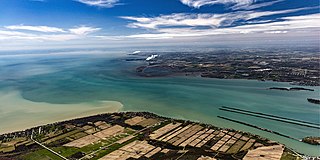
The Detroit River flows west and south for 24 nautical miles from Lake St. Clair to Lake Erie as a strait in the Great Lakes system. The river divides the metropolitan areas of Detroit, Michigan, and Windsor, Ontario—an area collectively referred to as Detroit–Windsor—and forms part of the border between Canada and the United States. The Ambassador Bridge, the Detroit–Windsor Tunnel, and the Michigan Central Railway Tunnel connect the cities.
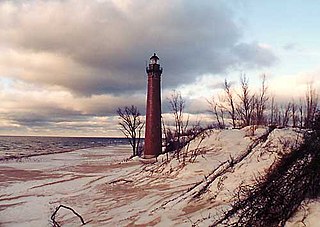
The Lower Peninsula of Michigan – also known as Lower Michigan – is the larger, southern and less elevated of the two major landmasses that make up the U.S. state of Michigan; the other being the Upper Peninsula, which is separated by the Straits of Mackinac. It is surrounded by water on all sides except its southern border, which it shares with Indiana and Ohio. Although the Upper Peninsula is commonly referred to as "the U.P.", it is uncommon for the Lower Peninsula to be called "the L.P."
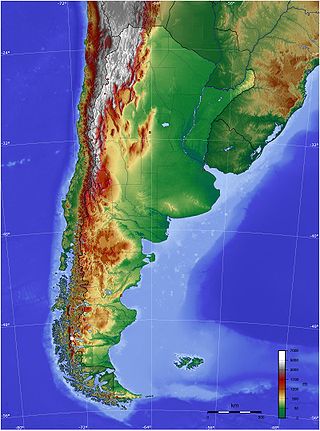
The geography of Argentina is heavily diverse, consisting of the Andes Mountains, pampas, and various rivers and lakes. Bordered by the Andes in the west and the South Atlantic Ocean to the east, its neighbouring countries are Chile to the west, Bolivia and Paraguay to the north, and Brazil and Uruguay to the northeast.

The Red River, also called the Red River of the North to differentiate it from the Red River in the south of the continent, is a river in the north-central United States and central Canada. Originating at the confluence of the Bois de Sioux and Otter Tail rivers between the U.S. states of Minnesota and North Dakota, it flows northward through the Red River Valley, forming most of the border of Minnesota and North Dakota and continuing into Manitoba. It empties into Lake Winnipeg, whose waters join the Nelson River and ultimately flow into Hudson Bay.
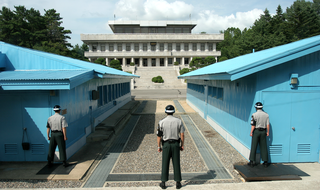
Borders are usually defined as geographical boundaries, imposed either by features such as oceans and terrain, or by political entities such as governments, sovereign states, federated states, and other subnational entities. Political borders can be established through warfare, colonization, or mutual agreements between the political entities that reside in those areas.

The Canada–United States border is the longest international border in the world. The boundary is 8,891 km (5,525 mi) long. The land border has two sections: Canada's border with the contiguous United States to its south, and with the U.S. state of Alaska to its west. The bi-national International Boundary Commission deals with matters relating to marking and maintaining the boundary, and the International Joint Commission deals with issues concerning boundary waters. The agencies responsible for facilitating legal passage through the international boundary are the Canada Border Services Agency (CBSA) and U.S. Customs and Border Protection (CBP).

The Rainy River is a river, approximately 137 miles (220 km) long, forming part of the Canada–United States border separating Northwestern Ontario and northern Minnesota.

The Connecticut Lakes are a group of lakes in Coos County, northern New Hampshire, United States, situated along the headwaters of the Connecticut River. They are accessed via the northernmost segment of U.S. Route 3, between the village of Pittsburg and the Canada port of entry south of Chartierville, Quebec. The lakes are located within the boundaries of Pittsburg, but are far from the town center. Connecticut Lakes State Forest adjoins them.

The international border states are those states in the U.S. that border either the Bahamas, Canada, Cuba, Mexico, or Russia. With a total of eighteen of such states, thirteen lie on the U.S.–Canada border, four lie on the U.S.–Mexico border, and one has maritime borders with Cuba and The Bahamas.

Area code 218 is a telephone area code in the North American Numbering Plan (NANP) for the northern part of the U.S. state of Minnesota. It is assigned to the largest of Minnesota's original two numbering plan areas (NPAs), although its geographical boundaries have been modified since inception. It comprises roughly the northern half of the state, and includes the cities of Duluth, Hibbing, Brainerd, Bemidji, Fergus Falls, and Moorhead.
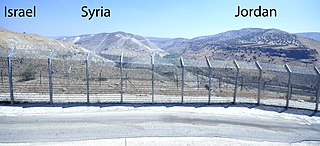
A triple border, tripoint, trijunction, triple point, or tri-border area is a geographical point at which the boundaries of three countries or subnational entities meet. There are 175 international tripoints as of 2020. Nearly half are situated in rivers, lakes or seas. On dry land, the exact tripoints may be indicated by markers or pillars, and occasionally by larger monuments.
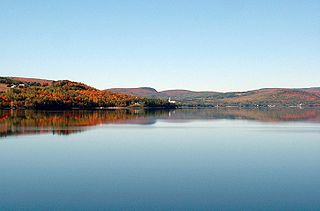
Pohénégamook, Quebec is a Canadian town on the Canada–United States border in Quebec's Témiscouata Regional County Municipality.

Falcon International Reservoir, commonly called Falcon Lake, is a reservoir on the Rio Grande 40 miles (64 km) southeast of Laredo, Texas, United States, and Nuevo Laredo, Tamaulipas, Mexico. The huge lake is bounded by Starr and Zapata Counties on the Texas side of the international border and the municipality and city of Nueva Ciudad Guerrero on the Tamaulipas side. The reservoir was formed by the construction of the Falcon Dam to provide water conservation, irrigation, flood control, and hydroelectricity to the area.

The history of post-confederation Canada began on July 1, 1867, when the British North American colonies of Canada, New Brunswick, and Nova Scotia were united to form a single Dominion within the British Empire. Upon Confederation, the United Province of Canada was immediately split into the provinces of Ontario and Quebec. The colonies of Prince Edward Island and British Columbia joined shortly after, and Canada acquired the vast expanse of the continent controlled by the Hudson's Bay Company, which was eventually divided into new territories and provinces. Canada evolved into a fully sovereign state by 1982.

The St. Francis River is a river roughly 75 miles (120 km) long, which forms part of the Canada–United States border. The river rises in a lake of the same name located 12 miles (20 km) east of the Rivière du Loup in Quebec. The portion that forms the boundary starts at the bottom of Lake Pohenegamook at the very northernmost point of New England between Estcourt Station, Maine, and Estcourt, Quebec. The river along the international boundary flows south and then south-east through two deep, narrow lakes to its mouth on the Saint John River at St. Francis, Maine/Saint-François-de-Madawaska, New Brunswick.

Lake Skadar – also called Lake Scutari, Lake Shkodër and Lake Shkodra – lies on the border of Albania and Montenegro, and is the largest lake in Southern Europe. It is named after the city of Shkodër which lies at its southeastern coast. It is a karst lake.
The Great Lakes Region is one of ten United States regions that currently sends teams to the Little League World Series, the largest youth baseball competition in the world. The region's participation in the LLWS dates back to 1957, when it was known as the Central Region. However, when the LLWS was expanded in 2001 from eight teams to 16 teams, the Central Region was split into the Great Lakes and Midwest Regions.
The Koochiching State Forest is a state forest located near International Falls in Itasca, Koochiching, and Saint Louis counties, Minnesota. The forest borders the Pine Island State Forest to the west, the Big Fork State Forest and George Washington State Forest to the south, the Nett Lake Indian Reservation and the Kabetogama State Forest to the east. A leg of the forest touches Rainy Lake to the north, which forms part of the international border with Ontario. Of the 565,500 acres (2,288 km2), 344,300 acres (1,393 km2) are managed by the Minnesota Department of Natural Resources, making it one of the largest forests in the Minnesota state system.